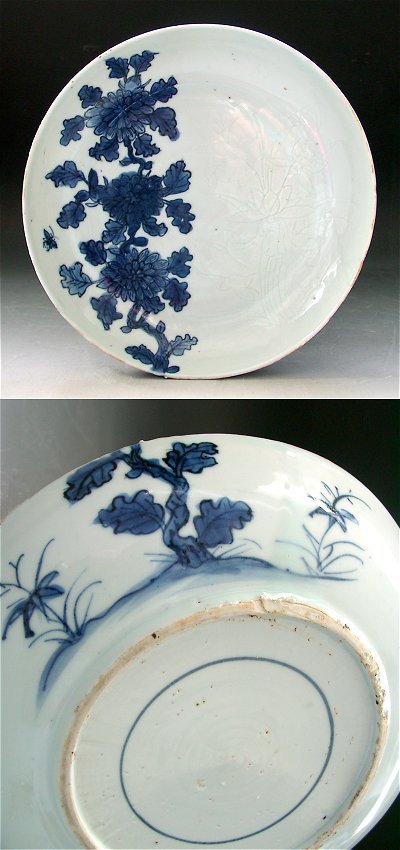
This page is only one of many thousands of Gotheborg.com Help and Information Pages, offering specialized knowledge on Chinese and Japanese Porcelain, including a Glossary, Q&A, Chinese and Japanese Porcelain Marks, Chinese Porcelain Exhibition and Excavation reports etc. For personal help and far more information, join our Discussion Board or use 'Ask a Question' for quick email consultations. For full text and better navigation, use a full-screen device rather than a mobile phone, that offers only limited content.

Late Ming Dish in Ko-Sometsuke style with Guoshi decoration
the meaning of the composition ("Guoqianzhi" ["Branch Over a Wall"]) evokes the expression "Changzhi" (long reign), thus the present charger would convey a wish for a long and prosperous reign
This dish is decorated with a very unusual decoration. At the inside left part of the dish there are three chrysanthemums, always strongly suggesting / symbolizing 'autumn' and 'retirement'. The number 'three' could just be an 'enforcement' but could also refer to the three schools of thoughts in China - Buddhism, Daoism, and Confucianism.
The underglaze blue decoration as such, is also a rare and very early example of Guozhi style porcelain decoration where a flower stem starts at the outside footrim and extends to the inside of the plate.
To the right there are an incised anhua (secret) decoration of flowers under a full moon. The incised right side flowers are the lotus - representing 'purity' (of the Buddhist thoughts) and an orchid, symbolizing 'distance' and 'far away'. When held up against a light, the light shines through the incised decoration on the area outside the foot rim. Inside the foot rim, the paste is thicker and the incised decoration is seen against the white paste similar to as on better Qingbai pieces.
From this point of view the decoration could be seen as a late Ming scholar considering to "retire, leave and stay clean" or even disappearing from public life and becoming a philosopher or hermit.
Regarding the date of this highly remarkable dish, I am not entirely sure. The color and style is very much in late 16th century style and I would very much like to say that this dish is from the Wanli or even better, from the Jiajing period, still I figure this dish could also be as late as the 1620s. Complicating matters further is that the base is clearly in imitation of the Japanese style of drawing, with a single circle inside the foot rim.
The dish has the typical weight distribution of a late Ming dish, slightly heavier than it looks, and is well centered. Its diameter is 8.25 inches (21 cm). It is also most definitely a Jingdezhen ware. My best guess for a date is late 16th century/early 17th century, Ming dynasty.
At the rim there are rim chips and broken blisters typical of the period. This is usually explained as that the glaze does not fit the porcelain body entirely, so it has contracted some at the edges. However, in his letter of 1712 the Jesuit missionary Pere d'Entrecolles writing about the porcelain industry from Jingdezhen, mention this kind of fritting, and explains that it was "caused by the potters touching the edges of the unfired porcelain with their hands". From around the mid 17th century this problem appears to have been dealt with by - obviously, maybe - by 'not touching', but also by applying a brown dressing to the outer edges of the porcelain pieces.
This difficult and sophisticated technique of painting branches that flow over the rim was favored by the Yongzheng Emperor, an artistic device referred to as changzhi in Chinese, meaning 'long branch', a homophone of the phrase "Eternal Governance".
A particular request by the Yongzheng Emperor, preserved in the records of the Zaobanchu, the workshops of the Imperial Household Department, reflects his interest in the "long branch" design:
"[In the] 19th day, 4th month, Yongzheng 9th year (1731) His Majesty ordered to take glazed and unglazed porcelain and paint on it the enamelled designs of Everlasting Tranquillity and Eternal Governance " (Feng Xianming, Annotated Collection of Historical Documents on Ancient Chinese Ceramics, Taipei, 2000, p. 222)
As we can see from this dish, the "long branch" idea was older than that since this dish predates the Yongzheng period with about one century.
Jan-Erik Nilsson